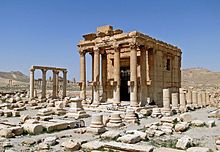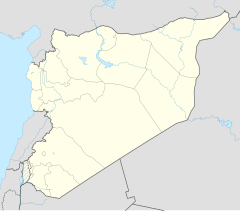Temple of Baalshamin
From Wikipedia, the free encyclopedia
Not to be confused with Temple of Bel.
| Temple of Baalshamin | |
|---|---|
| Name as inscribed on the World Heritage List | |
 The Temple of Baalshamin in 2010 |
|
| Location | Syria |
| Type | Cultural |
| Criteria | i, ii, iv |
| Reference | 23 |
| UNESCO region | Arab States |
| Inscription history | |
| Inscription | 1980 (4th Session) |
| Endangered | since 2013 (Destroyed in 2015 by ISIL) |
Location of Temple of Baalshamin in Syria. |
Contents
Architectural style
The temple was originally a part of an extensive precinct of threecourtyards and represented a fusion of oriental and Roman architectural
styles. The temple's proportions and capitals were Roman, while the elements above the architrave and the side windows represented an oriental tradition, with its highly stylised acanthus patterns of the Corinthian orders indicating an Egyptian influence.[3] The temple had a six-column pronaos with traces of corbels and the cella. The side walls were decorated with pilasters. An inscription in Greek and Palmyrene on the column bracket that supported the bust of temple's benefactor, Male, attested that the temple was built in 131 AD.[4] The inscription also mentioned the visit of Emperor Hadrian
to Palmyra around 129 AD and read as follows: "The Senate and the
people have made this statue to Male Agrippa, son of Yarhai, son of
Lishamsh Raai, who, being secretary for a second time when the divine
Hadrian came here, gave oil to the citizens, and to the troops and the
strangers that came with him, taking care of their encampment. And he
built the temple, the vestibule, and the entire decoration, at his own
expense, to Baal Shamin and Durahlun".[4]
Damage and demolition
Parts of the temple were damaged to some extent by bombings in 2013[5]during the Syrian Civil War. The southeastern corner of the temple wall
was damaged by looters who made two openings to steal the furniture of
the guesthouse.[5]
In July of 2015, ISIL planted a large quantity of explosives in the temple and exploded the temple.[6] There are conflicting reports if the demolition was Sunday August 23, 2015 or in July.[7] The demolition was announced by the head of the Syrian Directorate-General of Antiquities and Museums Maamoun Abdulkarim.[6] It occurred after ISIL was reported as stating that they did not intend to demolish Palmyra's World Heritage Site while still intending to destroy any statues it deemed "polytheistic".[8] UNESCO described the wilful destruction of the temple as a 'war crime'.[9][10]
See also
References
- Shaheen, Kareem (24 August 2015). "Palmyra: destruction of ancient temple is a war crime, says Unesco chief". The Guardian. Retrieved 25 August 2015.
this destruction is a new war crime

No hay comentarios:
Publicar un comentario